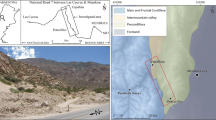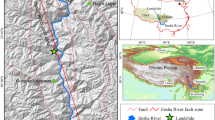Abstract
Laxiwa Hydropower Station is the largest among those hydropower stations in the upper reaches of the Yellow River. The construction started in October 2001, diversion tunnel was finished in January 2004, and impoundment started in March 2009. However, from May 2009, the right-bank slope of the reservoir about 700 m high and 1,000 m wide located 500 m far from the dam was found to be deforming greatly and continuously. Although this slope had been identified as an old landslide, the survey before the construction of the dam concluded that this slope being composed of granite is stable and would be stable even after the impoundment, and thus no detailed monitoring of the slope deformation had been performed before the visible deformation occurred after the impoundment. To indentify the relationship between the deformation of the slope and impoundment, we utilized differential synthetic aperture radar interferometry and Advanced Land Observing Satellite Prism data to analyze the slope deformation before and after impoundment. We found that no identifiable deformation took place before the impoundment, while during the period of 3 April 2009 to 22 May 2010, after impoundment, maximum horizontal displacement reached approximately 7.5 m. This slope is still deforming even after a total horizontal displacement of several tens of meters being reached, showing high risk of catastrophic failure.











Similar content being viewed by others
References
Antonello G, Casagli N, Farina P, Leva D, Nico G, Sieber AJ, Tarchi D (2004) Ground-based SAR interferometry for monitoring mass movements. Landslides 1:21–28
Burgmann R, Rosen PA, Fielding EJ (2000) Synthetic aperture radar interferometry to measure Earth’s surface topography and its deformation. Ann Rev Earth Planet Sci 28:169–209
Casagli N, Catani F, Ventisette CD, Luzi G (2010) Monitoring, prediction, and early warning using ground-based radar interferometry. Landslides 7:291–301
Colesanti C, Wasowski J (2006) Investigating landslides with space-borne Synthetic Aperture Radar (SAR) interferometry. Eng Geol 88(3–4):173–199
Fielding EJ, Blom RG, Goldstein RM (1998) Rapid subsidence over oil fields measured by SAR interferometry. Geophys Res Lett 25:3215
Galloway DL, Hudnut KW, Ingebritsen SE, Phillips SP, Peltzer G, Rogez F, Rosen PA (1998) InSAR detection of system compaction and land subsidence, Antelope Valley, Mojave Desert, California. Water Resour Res 34:2573–2585
Genevois R, Ghirotti M (2005) The 1963 Vaiont landslide. Giorn Geol Applicata 1:41–52. doi:10.1474/GGA.2005-01.0-05.0005
Kiersch GA (1964) Vaiont reservoir disaster. Civ Eng 34:32–39
Massonnet D, Rossi M, Carmona C, Adragna F, Peltzer G, Feigl K, Rabaute T (1993) The displacement field of the Landers earthquake mapped by radar interferometry. Nature 364:138–142
Massonnet D, Briole P, Arnaud A (1995) Deflation of Mount Etna monitored by spaceborne radar interferometry. Nature 375:567–570
Massonnet D, Holzer T, Vadon H (1997) Land field, California, observed using SAR interferometry. Geophys Res Lett 24:901–904
Müller L (1964) The rock slide in the Vaiont Valley. Rock Mech Engng Geol 2:148–212
Riedel B, Walther A (2008) InSAR processing for the recognition of landslides. Adv Geosci 14:189–194
Semenza E, Ghirotti M (2000) History of the 1963 Vaiont slide: the importance of geological factors. Bull Eng Geol Env 59:87–97
Singh LP, vanWesten CJ, Champati RPK, Pasquali P (2005) Accuracy assessment of InSAR derived inputmaps for landslide susceptibility analysis: a case study from the Swiss Alps. Landslides 2:221–228
Skempton AW (1966) Bedding-plane slip, residual strength and the Vaiont landslide. Geotechnique 16:82–84
Ward SN, Day S (2011) The 1963 landslide and flood at Vaiont Reservoir Italy. A tsunami ball simulation. Ital J Geosci (Boll Soc Geol Ital) 130(1):16–26
Yin Y, Zheng W, Liu Y, Zhang J, Li X (2010a) Integration of GPS with InSAR to monitoring of the Jiaju landslide in Sichuan, China. Landslides 7:359–365
Yin Y, Wang H, Gao Y, Li X (2010b) Real-time monitoring and early warning of landslides at relocated Wushan Town, the Three Gorges Reservoir, China. Landslides 7:339–349
Acknowledgments
The research work described herein was funded by the National Nature Science Foundation of China under grant no. 40772187. The financial supports are gratefully acknowledged. The valuable comments by Dr. Alexander Strom (Hydroproject Institute, Moscow), Dr. Hans-Balder Havenith (University of Liege), and Dr. Yuepin Yin (China Geological Environment Information Site) are greatly appreciated.
Author information
Authors and Affiliations
Corresponding author
Rights and permissions
About this article
Cite this article
Zhang, D., Wang, G., Yang, T. et al. Satellite remote sensing-based detection of the deformation of a reservoir bank slope in Laxiwa Hydropower Station, China. Landslides 10, 231–238 (2013). https://doi.org/10.1007/s10346-012-0378-9
Received:
Accepted:
Published:
Issue Date:
DOI: https://doi.org/10.1007/s10346-012-0378-9




